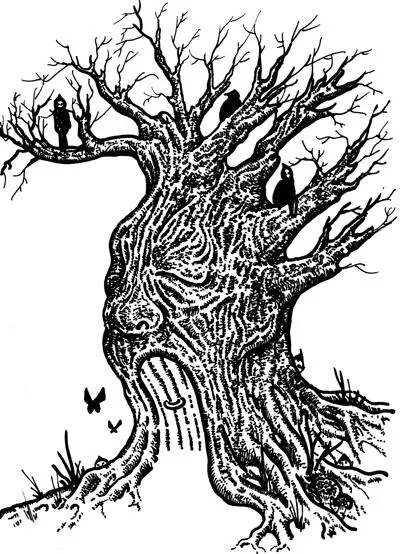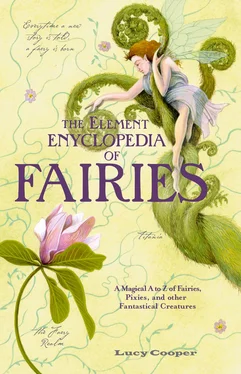In Ireland, the Tuatha de Danann were once believed to be the children of the goddess Don, otherworldly beings with supernatural powers. Conquered by the invading Milesians, they took to the hollow hills and became the Daoine Sidh (pronounced Deeny Shee ). They battled and mated with the warriors of the Fianna Finn and over the years dwindled in stature. Originally the same size or larger than humans, down through the generations they shrank to the size of children, or smaller.
This theory overlaps with ideas of the vanquished race, driven to live in the hills. As with all beliefs surrounding fairies, the boundaries are blurred and we are left to draw our own conclusions. Suffice to say, belief in supernatural beings, in various forms, who are neither gods, nor strictly speaking ghosts, and who can intervene in human lives is widespread across many ancient cultures and peoples, from the Far East, where they have long played a role in romances and stories, to the ancient Hindu tradition, where they inhabited Earth long before the creation of humanity, to Persia, where the peris lived in enchanted palaces and castles and fought the malevolent forces of the divs .
Nowadays it’s common to think of fairies as small or even tiny winged creatures. However, that hasn’t always been the case. In earlier times, they were often life-sized, or larger. The Irish Sidh were as tall or taller than humans. An Irish “seer,” one for whom fairies are visible, once described opalescent beings of about 14 feet (over 4 meters) in stature and shining beings of about human height, or a little taller.
From the Fates to the Fairies
The word “fairy” has been through nearly as many transformations as beliefs about the creatures themselves. It originates from the Latin root fatum , meaning “destiny” or “fate.” Fata , the plural of fatum , was the name given to the classical Greek and Roman female deities said to be present at a baby’s birth and to determine the future course of that life. These Fata , or Fates, the three daughters of the night, were Clotho, Lachesis, and Atropos. Clotho spun the thread of each individual life. Lachesis shaped and twisted the thread. Atropos took her shears and cut the thread at the appointed time. In Spain, they were known as the Hadas , and in France as the Feés . In Albania, the Fatit rode in on butterflies three days after a birth to determine the course of the child’s life.
The belief in the Fates as guardian spirits who watch over us, especially at times of transformation such as birth and death, has endured over time and they have entered into popular fairy tales, such as the story of Cinderella , in the form of fairy godmothers.
From this root, we get the French verb faer , or féer , meaning “to enchant.” From that we get faerie , or féerie , which originally referred to a state of enchantment, but which also came to apply to the “enchanter” as well. By the seventeenth century, a whole host of names, including “fairfolks,” “farie,” “fairie,” “fairye,” “fairy,” and “faery,” seem to have been in use.
Today “fairy” and “faery” are most commonly used to talk about fairy creatures, and “fairyland” or “faery” or “faerie” to talk about the place where fairies live (which goes by many other names in different cultures too).
Some use “fairy” to refer to the small, winged creatures most associated with the Victorians and flower fairies, and “faery” to talk about the wider group of beings with roots that originate in ancient times and places, and reach out to include nature spirits—mermaids, hobgoblins, brownies, elves, and a whole host of related beings. There is no one “correct” use. Here, “fairy” is used to refer to the many wonderful and varied creatures that make up the diverse fairy world.
Names have always been a slippery issue when it comes to fairies. Out of deference, or fear of causing offense, humans have traditionally referred to them by other names and euphemisms, such as the little people, the good folk, the fair folk, or the good neighbors. There are many names for them in the British Isles alone. The Ad-hene Manx on the Isle of Man, meaning “Themselves,” is a name humans must get right and never take in vain. The Daoine Sidh in Ireland, the Sith in the Scottish Highlands, the piskies in Cornwall—the names go on and on.
Folklore gives us many examples of where finding out a fairy’s true name can bring power over the creature, such as in the tale of Rumpelstiltskin , where a girl must guess the name of her mysterious helper to gain power over him and avoid a curse. The same is true in the Cornish and Scottish tales “Tarraway” (or “Duffy and the Devil”) and “Whuppity Stoorie.” Here you will learn the names of many hundreds of fairies.
Many attempts have been made to categorize fairies. Thomas Keightley, the author of The Fairy Mythology (1828), divided the beings into “Fays or Fairies of Romance” (human-sized beings endowed with special powers) and “Elves or Popular Fairies” (diminutive beings). Characteristically, fairies have defied categorization—and you will find them all here.
Invisible lands across the sea, hollow hills that raise themselves up on legs at full moon, revealing the twinkling lights of the fairy homes within, underwater palaces and castles in the sky, streams, lakes, mountains, forests, woods, trees, and flowers, under a rock or at the bottom of the garden—fairyland, like fairies themselves, comes in many different guises.

In the county of Cornwall alone, descriptions of fairyland and fairy dwellings range from the fantastical to the everyday. In “The Lost Child” in Robert Hunt’s Popular Romances of the West of England (1865), a little boy who follows the sound of exquisite music into the woods describes being led by a beautiful lady into a fabulous palace with glass pillars and glistening multi-colored arches hung with crystals. In contrast, another account states that one of the favorite haunts of the fairies are simply “places frequented by goats.”
From otherworldly palaces to mundane hillsides, fairyland is elusive, remaining always just around the corner—glimpsed briefly, disappearing in the twinkling of an eye.
Celtic tradition abounds with tales of mythical enchanted isles located somewhere across the western sea, visible only briefly to mortal eyes before disappearing again into the mists. Tir Nan Og , Land of the Ever Young, is where the Tuatha de Danann are supposed to have resided since being chased from the mainland by the Milesians. In Manx folklore, it is the Isle of Emhain, Land of the Women. To the Britons, the Isle of Man was a magical land. In “The Magic Legs” in Fairy Tales of the Isle of Man (1963), Dora Broome tells of the mist-hidden island that Mannanon, Son of Lir, could make invisible at will. In Wales, sailors told tales of isles of enchanted green meadows off the coast of Pembrokeshire and Carmarthenshire.
The land of Avalon is one of the most famous of the fairy lands across the sea. This is where some believe King Arthur lies sleeping, awaiting the hour when he will return to rule again.
In Old Norse mythology, there are Nine Worlds which are home to the various types of beings, including humans, elves, gods, and goddesses, that make up the Old Norse worldview. These worlds are held in the branches and roots of Yggdrasil, the World Tree. Alfheim is the world of the elves. Asgard is the world of the Aesir tribe of gods and goddesses, located in the sky, invisible to human eyes but linked to the human realm by the rainbow bridge Bifrost. Midgard is the name given to the human world.
Читать дальше













